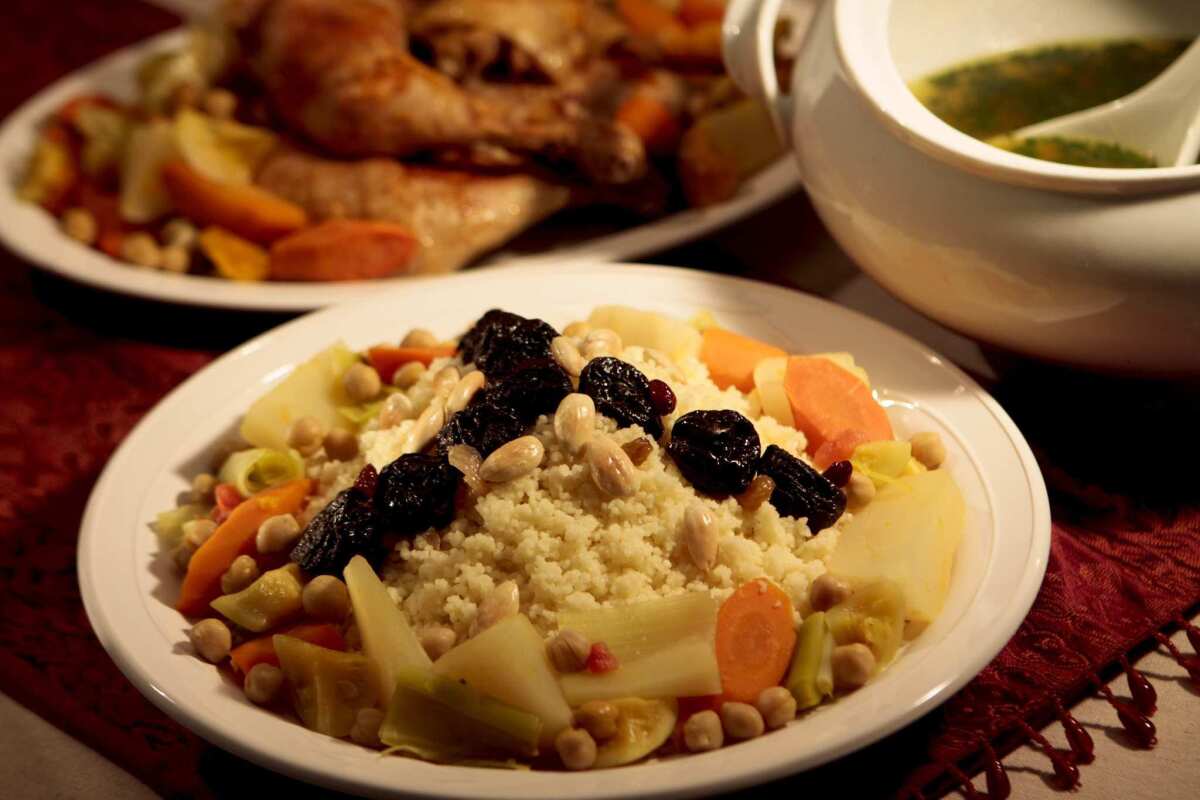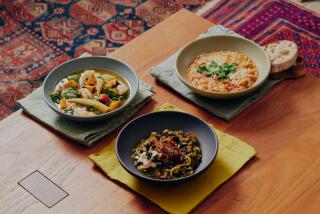Recipe: Couscous with seven blessed vegetables

Couscous with seven blessed vegetables
Total time: 3 hours, 45 minutes (plus 2½ hours cooking time for the dried chickpeas if using)
Servings: 6
Note: This recipe includes vegetables baked with sugar and cinnamon. They can be served as an appetizer for the Rosh Hashanah blessing ritual or can accompany the couscous. It is best to cook the chicken a day or two ahead and to refrigerate it, so that skimming the fat from the broth is easier. If you don’t have kabocha squash, substitute butternut or other orange-fleshed squash.
2/3 cup dried chickpeas (4½ ounces), sorted and rinsed, or 1 (15-ounce) can
Salt and freshly ground pepper
1 large leek (about ¾ to 1 pound)
4 small whole chicken legs (drumsticks attached to thighs, sometimes labeled chicken leg quarters) (about 4 pounds)
1 onion, quartered
1 stalk celery, if desired, cut crosswise into thirds
6 to 8 sprigs plus 1/3 cup chopped cilantro, divided
6 to 8 sprigs Italian parsley plus 1/3 cup chopped parsley, divided
1/4 teaspoon saffron threads
2 small plum tomatoes (about 5 or 6 ounces), peeled and chopped (about 2/3 cup chopped)
3/4- to 1-pound piece kabocha squash, scrubbed, seeded and peeled, cut in two
6 carrots (about ¾ pound) , cut on the bias into ¾- to 1-inch pieces
2 small turnips (about ¾ pound), peeled and cut into 8 pieces
3 Mexican squash (also called white squash or Mexican zucchini) (about ¾ pound), halved lengthwise and cut diagonally into 1-inch pieces
Olive oil, for drizzling
1 teaspoon sugar
Ground cinnamon, for garnish
Paprika, if desired, for garnish
Cayenne pepper, if desired
Steamed or quick couscous
Dried fruit and almond garnish
1. If using dried chickpeas, put them in a small saucepan and add 3 cups water. Cover and bring to a boil over medium heat. Simmer over low heat for 1 hour, adding additional hot water if necessary to keep them covered. Add a pinch of salt and simmer until tender, about one to 1½ hours more. Remove from heat and set the chickpeas aside, still in their liquid. If using canned chickpeas, drain and rinse the chickpeas, cover and set aside.
2. Cut off the dark green tops of the leek and rinse them thoroughly. Put the leek greens in a couscous or soup pot or a large stew pan. Set aside the rest of the leek to use later.
3. Add the chicken to the leek greens in the pot. Add the quartered onion, celery ribs and enough water to cover the ingredients, about 8 to 10 cups. Bring to a boil over high heat, skimming any foam that forms on the surface. Reduce the heat to low and simmer for an additional 10 minutes, skimming any foam. Add the sprigs of cilantro and parsley, the saffron and a pinch each of salt and pepper.
4. Cover and simmer over low heat until the chicken is just tender and the meat near the bone is no longer pink, about 45 minutes; when the chicken is pierced in its thickest part with the point of a knife, any juices that come out should be clear, not pink. Discard the soup vegetables and herb sprigs. Remove the chicken with a slotted spoon and cool the chicken and broth separately. (The recipe can be prepared up to this point a day or two in advance; cover and refrigerate the broth, chicken and chickpeas until needed.)
5. Skim any fat from the surface of the broth, then bring the broth back to a boil over high heat. Add the tomatoes, kabocha squash, carrots and turnips to the broth. Cover and simmer over medium-low heat for 15 minutes.
6. While the broth is simmering, cut the white and light green part of the leek in half lengthwise and rinse it thoroughly, checking to make sure there is no sand between the layers. Cut the leek crosswise into 1½- to 2-inch pieces and check them again for sand.
7. Add the leek to the broth. Add the cooked chickpeas, along with their liquid if desired, or the drained canned chickpeas. Return the broth to a simmer. Cover and cook over low heat for 5 minutes, then add the Mexican squash and return to a simmer. Cover and cook until the vegetables are tender but not falling apart, about 7 minutes.
8. Remove 4 cups of the vegetables with a slotted spoon. Remove the kabocha squash pieces and cut them into bite-sized cubes. Add them to the other vegetables.
9. To reheat the chicken, add the pieces to the hot broth and simmer them gently until heated through, 10 to 15 minutes.
10. Heat the oven to 400 degrees. Place the removed 4 cups cooked vegetables in a shallow 2-quart baking dish, drizzle with 1 tablespoon olive oil and sprinkle with the sugar. Bake the vegetables until they brown lightly, about 20 minutes. Sprinkle them lightly with cinnamon. Serve them as an appetizer or as an accompaniment for the couscous.
11. If you would like to brown the chicken, remove the hot chicken pieces from the broth, draining them well. Put them in a roasting pan. Drizzle them with 2 to 3 teaspoons olive oil, rub the oil over the chicken and sprinkle lightly with salt and paprika. Bake the chicken, uncovered at 400 degrees, until lightly browned, about 15 minutes. If you like, separate the drumsticks from the thighs. Transfer the browned chicken to a platter; cover and keep warm. If not browning the chicken, serve the reheated pieces on a platter, or remove the skin and bones and serve the cut-up meat in the broth.
12. Heat the broth with the vegetables until very hot. Drain the vegetables if you want to serve them on the side, or leave them in the broth. Add the chopped cilantro and parsley. Taste and adjust seasoning, adding cayenne if desired.
13. To serve the couscous, mound it in a cone shape on a large platter, garnished with the dried fruit and almond mixture as well as some of the vegetables. Serve the remaining dried fruit and almonds, vegetables and chicken in bowls or platters on the side.
14. Serve the couscous in shallow bowls. Serve the broth from a tureen, for moistening the couscous to each person’s taste. Top each portion with chicken, vegetables and fruit and almond garnish.
Each serving, without couscous: 635 calories; 43 grams protein; 33 grams carbohydrates; 9 grams fiber; 37 grams fat; 10 grams saturated fat; 205 mg cholesterol; 12 grams sugar; 365 mg sodium.
More to Read
Eat your way across L.A.
Get our weekly Tasting Notes newsletter for reviews, news and more.
You may occasionally receive promotional content from the Los Angeles Times.










